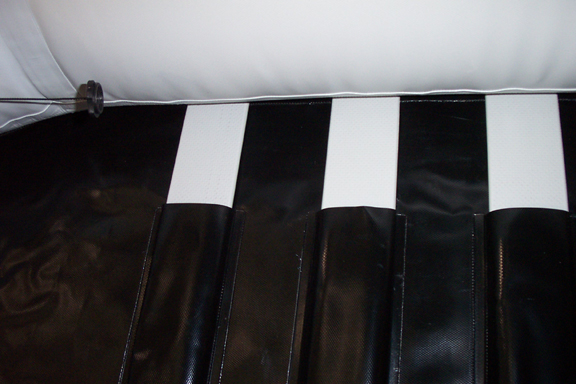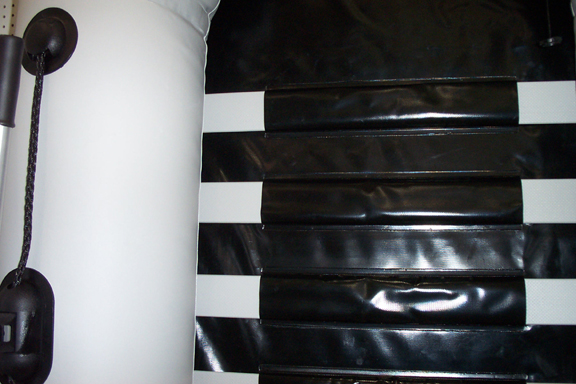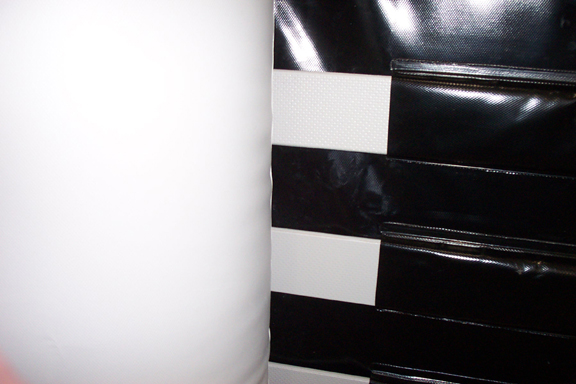

<Home> <500 Auxiliary Machinery>

Added 03/26/2004
Hey guys!
We're thinking about replacing the solid plywood floor or the dinghy with
slats that can be rolled up.
Any ideas on what material to use and how to finish it?
I was thinking having whatever we use for the slats about an inch apart and
holding the whole thing together with a length of 2" webbing run down
each side.
Kip & Beth
"Moonbreeze"
C36 #326
Gettysburg, PA
Severna Park, MD
Kip, I'd go to a boat
store and look at how Avon etc. do it first. Keeping
each slat in its respective position fore/aft will be the challenge.
Dan
Kip,
That is something I have wanted to do as well. I would think that plastic
of some kind(starboard?)would work for the slats. Another idea might be to
sew 2 layers of polipro awning shade fabric together (the open weave shade
cloth) with stitching rows 2" apart making pockets you could insert the
slats into.
Cap'n Jonny
Just throwing this out
for interest sake, what about using the decking
material made from recycled plastics, it is supposed to be rot proof and
have a very long life as well as being sawable, cheaper than starboard
and some of it has a wood imprint. Also for those out there with walker
dinghies, they have an inflatable "rubber" skirt available that runs
around one thousand dollars, Great idea for improving stability and
floatation but a mite expensive for many of us. I thought that if you
made a tube from a heavy fabric then filled the tubing with a series of
bumpers and attached this to the side of the walker you would get the
same effect at about 1/5 the price. Just another thought.
Glenn Spicer C26T
Glenn:
I work at a park with a very nice mile-long boardwalk in St. Petersburg, FL.
We replaced some of the pressure-treated lumber with the stuff you're
talking about in several areas of the boardwalk. It's been there for at
least 7 years and has not changed in that time. All the wooden boards
are
checked, split, splintering, and have slippery mold growing on them. We
pressure-wash the whole boardwalk 4 or 5 times a year or people slip all
over when it rains. We have to replace them in sections every couple of
years. This is Florida, remember. This park gets 360,000 visitors a year.
Comments about the recycled plastic boards are 1) that it is very slippery
when wet. 2) It is very flexible and needs to be supported at much closer
spacings than the standard boards. So we have double the numnber of
stringers where the plastic ones are. 3) It is outrageuosly expensive.
Redecking the entire boardwalk with pressure-treated lumber would be around
$600,000. With the recycled plastic stuff, it woud be at least four
times
as much.
But it's a great idea for some applications.
Steven Gaber
Sanderling, 1967 C-31 #77
Oldsmar, Florida
Hey C.J.
I was thinking of the pocket idea...I have some extra sunbrella material
that would work just fine. Now all we have to do is come up with a
suitable material for the slats. A lot of folks have offered that
Starboard might be too heavy, or not good for weight-bearing.
Maybe a 1/2 - 3/8" plywood sealed with epoxy would be the way to go.
Our current solid plywood floor is in 4 big pieces held together with
the plastic "H" strips. The dinghy itself rolls up very nicely, but
getting the plywood pieces all together in the right place with the
strips right is a real PIA. Being able to deflate the whole thing and
roll it all up would be soooooo much nicer!
Kip
kip
I too have one of the old style dinghy's with the plywood floor - what a
pain to assemble!
Another source of plastic might be the garden edging sold at landscape
stores. Around here it is black or brown, is probably made from recycled
plastic and is about 6" x 1/2" by 10' long. while not as stiff as
large
sheets of plywood it might do the trick.
Cap'n Jonny
I took some pictures
at a BUS store of a Zodiac AX-3 dinghy. This one comes with a slatted floor.
The slats are about 3-1/2 inches wide and the ends tuck underneath the
inflated tubes. The slats live in pockets in the bottom of the dinghy. These
pockets are formed in a second layer of dinghy fabric glued to the bottom of
the dinghy. I took some pictures to better illustrate what I tried to
describe. The slats themselves appear to be about 3/8” thick, made from some
type of plywood encapsulated in some sort of resin with a non-skid surface on
the top,
Paul

